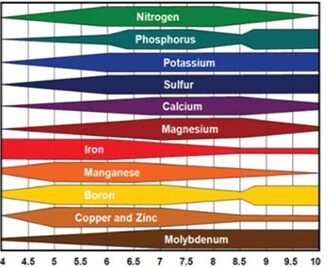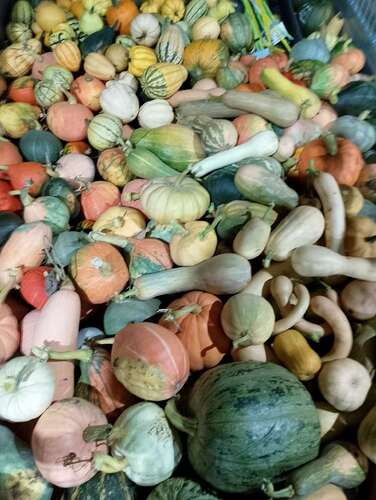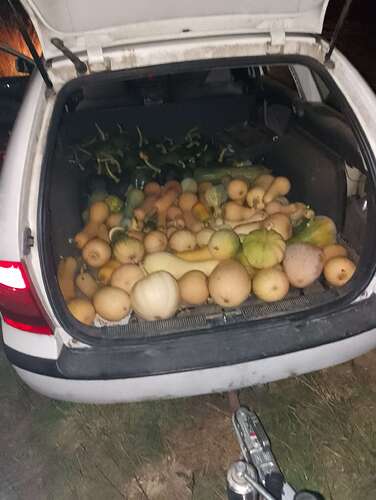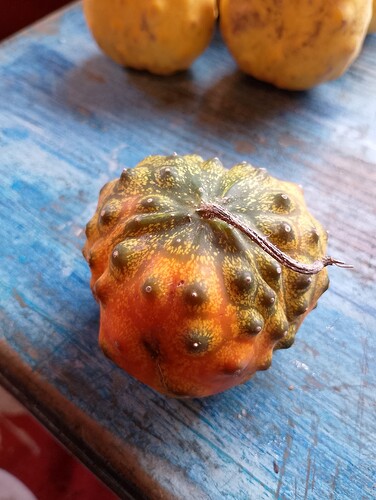Really enjoy seeing the, " artistic patch" as my entire garden looks that way. I have a small space and its always crowded with variety. Its a kitchen patch and keeps us with good foods.
I have had loads of melons and watermelons too, and of each 3 populations: early / normal / keeper… not “airtight”!.. Exemple: if I find some early ones in my “normal patches” I sort their seeds with the early, if I find some storage ones in ly “'normal patch” I sort them with the keeper
Also: each of my patches’ seeds are sorted by taste in three drying containers : “medium”, 'good" (=enjoyable), “excellent”. Medium (or “so so”) accounting for 50%, good for 40%, excellent for 10%. Approximately…
In later year I will centralise the excellent (40% of my patch), with around the good (50%), and then surrounding in thin line the “medium” (10%).
Why am I keeping the “medium” (or “so so”…) in my patch? It’s because as I have reintroduced loads of genetics this year, I consider it still as a grex: I want diversity first thing, meaning : crossings with new genetics, each of them seen as a supplementary chance of finding great offsprings
I do also a strong flavor selection each time, which is what “spatialize” later years.
Overall it has been a great cultivation year. If I didn’t have to go to Antibes, I would have harvested in a week or so… That may be inducing precocification of my grexes, i.e. more earliness in fruiting.
So you’ve seen it:
- large oversowing by type (sorts 30 feet apart or so)+ super strong selection pressure at young stage… (Eliminating 95%)
- … Then marking of the earliest (for scandinavians notably)…
- …then harvesting a bit early…
- …and eventually sort by taste…
- … to spatialize by by sort X by taste in later years
The good thing is that I am done with bringing in new genetics, with these 12-15 grexes very diverse now as I have brought in every interesting thing I could get my hands on using our directory of european seed sellers… So I will be able to concentrate on the selection process in next years, as I’ll have more seeds than needed, so could do exagerated sowing and culing at first stage for example.
From 6 or 7 varieties in the edible gourd grex to about 50 in the standard watermelon one…
… All in line with a direct sowing objective post cover crop at +3-5 years from now… Hoping to get then super strong vigor + incredible tastes…
Beautiful harvest!
If I were to go into agronomical details, i.e. what my landraces will ultimately have to adapt to, I must say that
- my weather is kind of “easy” (last frost around mid april, first frost around mid october, so 6 months growing perdiod)
- but my soil is super acidic with ph 4.5-5 …
- … and super draining (mostly sand, no clay): meaning drying down super fast and never gets really rehrydated in depth, as soon as mid July.
- consequence being super oxydised plants, and soil food web accordingly really weak : boosted from april to mid-June, stopped in the summer, restarting with the rains coming back, approx 1st October.
I have got the chance of having there a pond, so I can irrigate once in a week minimum when necessary, using sprinklers
My yields are so relatively low even if I brought in some good quality manure in fair amount this year, which I think I won’t do anymore. And I believe that the nutrient deficiencies caused by low ph…

… are the main limiting factor.
As my main (if not only!) objective is to landrace breed for this soil and climate + adapted to my no-till / cover crop system, I tend not to be willing to correct or compensate this places’ deficiencies.
If I were to cultivate to make a living of it, I would, either go to some better place, or :
- in october (as the calcium disolves in cold temperatures) make a yearly soil correction with lime (400kg/ha/yr in no till, i.e. 4kg on a 100m² garden)
- coat my seeds with oxygenated compost tea, and direct sow them by hand still wet (no drying… super easy). If I wanted to use the same tool I used this year, I would have to dry them first… which is contradictory to the use of micro-organisms…
- spray a cocktail of minerals (i…e a few grams/ha only, using a manual sprinkler) once in a month in growing season (see graph above)
- help the plants protect themselves from oxydation using lactoferments, which are really easy to produce (with fruits remaining immature at the end of season for ex. like these next days I will do), and rich in antioxydants, so helping the soil to balance a bit and are super well absorbed through leaves. Sprinkling before too much stress. 5liters each time, mixed with about 15 liters of water, for my whole 2000m² garden. Takes an hour or so.
- To boost a bit the overall soil food web, I would sprinkle the equivalent of 100L/ha when the soil gets realy wet again, with living roots of my cover crops already installed (otherwise it makes no sense, as this booosts what is already alive, not bare ground). That, possibly during heavy rains, using my irrigation system via a Venturi type thing coupled with it. At least as important as the calcium part, and that I can produce for not a penny.
Regarding cucurbits X my soil : seeming
- worse adapted : cucumbers,
- not-so-adapted: melons, pepo,
- just “OK”: maxima, moschata,
- obviously well adapted : gourds (lagenaria), watermelons,
- super adapted : kiwanos
Is the trailer coming to Antibes Thomas? Great harvest!
It’s where I would love precise discussions around our understandings in breeding landraces, i.e. the debate “compensating” - or not - “imbalances”.
Right now my understanding is that:
- There, we all want to breed for adaptation to our soils. Meaning : all we correct or compensate with heavy hands-on techniques during the first years selection processes is contradictory to the objective of local adaptation…
- … but we still want to make a harvest, and of good quality…
- …not everyone sees the same techniques and products as super “hands-on”, or even destructive. Not the same understandings also (see the “compost as a limiting factor” topic for example, could have been tilling, or many other subjects).
Then it’s up to each of us to understand what is most important, and put things in his/her personal context, perspective.
My personal inclination is to go with these principles :
- no tilling
- “winter” cover cropping in between summer crops
- and then do minimal corrections to help boost the soil food web itself… as I don’t want to boost my crops themselves… I help the soil getting better, a.k.a. let’s say I am “landracing my soil” using home-made products (lactofermentations)… Maybe adding calcium, as it is a relatively low energy and low cost product, for such surfaces.
My belief (after Joseph), is that if plants can do well in my place they could do well anywhere else. From experience I know that this is not exactly that, but that gives an idea, and as nearly all breeding work has been done on balanced soil, with “balance climate” over the past 150 years, it seems relatively consistent.
Then, even if I tend to be firm on principles, it’s all about adjustments… I have had to rototill my field this year unfortunately… otherwise I just could not start a growing season! I was supposed to leave the place, but eventually not. So adjusted. Then I went into heavy selection pressure on early vigor, with nearly 100% of the plants direct sown and selection pressure up to 95-99% on that criteria, i.e. culling 95-99% of young plants.
Hey Hugo, yes : not the trailer itself, but let’s say 1 fourth of this harvest + melons, watermelons, gourds, and kiwanos.
That’s one big table filled!
Yes but it’s not for any table, it’s for the space on the side of GTS / PEPS stands (see drawing sent in PM yesterday to those coming in Antibes). That set up has been confirmed yesterday evening by the local organisors, by the way.
Keeper watermelons and melons on my terrace… Will be brought to Antibes
“Standard” watermelons (i.e. not “early” and supposedly not “keeper” : my 2 other populations - see previous posts in that topic) on which I will do taste selection in next days:
Watermelon is very promising on my land.
- Late “standard” melons (about the last fourth remaining)
Less promising but we never know what will happen when landraced!
That is some low pH! You are making me question some ideas I’ve been developing about solicitity and squash.
Our soil types and climate are not exactly the same, but they are similar. I have been theorizing that some species and varieties of squash have a hard time accessing the nutrients in my soil when the pH is lower than 6. C. pepo and C. argyrosperma seem to be okay with lower soil pH. Maybe ficifolia too. Whereas moschata seems to have the most trouble with my soil, and I’m thinking it may be pH related to some extent.
My speculation is that if I want to improve my soil, it might be more worth my time to increase the pH than to add nutrients.
You did not mention trying to raise your soil pH among the possible approaches you are considering. I’m curious whether you have considered it.
Actually it’s not lime : it’s ground limestone (less agressive)
So yes I consider it, and will add this 400kg/ha/year around october. Then during growing season, you can’t do much and when it’s hot it’s too late for correcting your ph: foliar being the most cost effective way of helping plants, either with antioxydants (ex: lactofermentations diluted a bit) or/and with minimal doses of nutrients made inaccessible because of oxydisation. And as indicated in the graph above it’s not that the nutrient aren’t there, it’s they become blocked, not accessible.
Man who helped me understanding that was Olivier Husson last year in Marciac France when walking in a field with him, him explaining it’s -at best- pointless using something to (try to) correct soil ph during growing season in order to make nutrients available… much better going for low-cost, small quantities foliar sprays.
This is all related to Eh-Ph and I am no chemist, so can’t tell you more. But you can listen to Olivier, interviewed by John Kempf or Matt Powers for example.
But as I was saying I won’t do this while breeding landraces. Would use micronutrients -maybe- if I needed to make a living from agriculture, i.e. boosting plant health and so fruiting, yields.
Thank you for your thoughtful response, and pointing out where I had missed some detail previously.
For me it is also important that any amendments also fit into the concept and philosophy of what I’m trying to do. I have been thinking about how my predecessors on this land would have been amending the soil with ashes from burning wood and brush. So if I’m applying limestone, I can tell myself what I’m doing parallels a more sustainable approach that could be used with wood ash.
I’ve gotten some advice from a farmer in my region that uses permaculture principles. If I understood her, she amends with crushed limestone as much as she deems appropriate when first establishing a new bed. But afterward she has not needed repeated applications. I have wondered if she is composting certain plants on her beds or doing other methods to keep the pH balance. This person is not very near me but maybe I will have a chance to talk to them again over the winter to get more advice.
Crushed limestone is the only amendment that I’ve applied at the farm, on an experimental basis this year. I certainly will not be applying it every year or even regularly.
Thanks for sharing your information and photos about what you’re doing.
Winter squash taste selection eventually summarized here, with watermelon and melon selection summarized also in next post under this one: Direct seed exchange among EU members 2024-2025 - #21 by ThomasPicard
Kiwano selection. Done with fruits around 15th of november, i.e. one to two months post harvest.
There was about 20 square meters of kiwanos, 4 plants per square meter (high density to make more crossings), first selection on vigor (elimination of 80-90% of the less vigorous direct sown kiwanos), and then the harvest was about 40kgs, i.e. 2kg/m2. This yield could be much bigger in better soil and/or with longer growing season.
Grex made out of originally 3 strains: one round all yellow (200-250grams), one oval medium sized (300gr), one oval long sized (350gr)
Appeared intermediary phenotypes since crossings :
I first took good looking fruits of each appearing phenotype:
Then cut them in 2:
Eventually I selected for sugar content, using a refractometer as it appeared that the more sugar content the best the taste was - sugar content being the most limiting factor for kiwano use and acceptation. So the high brix level correlated perfectly with “good taste”.
And so I kept for seeds those with the higher brix level in each category (namely a level of BRIX of 6 for most, apart from the 5,5 of the “giant cross”: 420grams):
After drying I have kept seeds of these best kiwanos in each category in different zip bags. So I have 6 lots (+ a lot of the random early ones)
Examples before seed extraction and drying:
Improvements and questions for next year:
-
Yield estimation was impossible due to high planting density… Everything was intertwinned!!! Next year I will interplant on all sides with other crops to be able to estimate and select high yields on top of good taste, i.e. sugar content.
-
I still don’t have a clear understanding of how kiwano stores and how and if I should select on storing “behavior” : nearly 3 months after this selection I am still eating some which were harvested green at the same time with these others in pictures… My feeling is that even if the green ones mature, turning yellow-orange, the best are eaten at harvest, when they are already yellow-orange.
-
also it’s a quite late fruiting species, so I could select on earliness.
-
I wonder if sugary content is very different between individual plants or is it mostly a maturity thing per fruit - as all “best fruits” were all at 6 BRIX whatever the phenotype and these high brix level were always correlated with maturity traits of the fruits, ine. skin turned orange-yellow.
-
one thing I have confirmed is that if the inner flesh was pale green the kiwano were low in sugar. However intense green did not correlate always with the highest brix rate within each phenotype.
In summary, selection for 2026 could be a mix of these criteria :
- precocity
- high sugar content (brix 6)
- high yield
That maintaining a diversity of appearant phenotypes, as a way to keep diversity.
Then, I am still thinking about bringing in more diversity from landraces of around the world. See that post for example. This document assesses the diversity in a group of different Kenyan landraces :
Agro-morphological_characterization_of_horned_melo.pdf (1019.5 KB)
And those to get some overviews from over angles:
35.Micu1_D.pdf (295.4 KB)
Kiwano_Cucumis_metuliferus_E_Meyer_Ex_Naudin_respo.pdf (823.3 KB)
PlantBreeding-2024-Sebati-AfricanHornedMelonCucumismetuliferusClimateResilientCropandGeneDonorinthe.pdf (10.0 MB)
Quantitative_and_Qualitative_Production_of_Species.pdf (632.9 KB)
Immunological_Activity_and_Gut_Microbiota_Modulati.pdf (9.0 MB)
This is all groundcherries, of the best taste I know, 8 first pruinosa, 9th unidentified (was volunteer in 2023), 10 to 12 sypposed floridana and viscosa, but probably not viscosa (@JesseI ). Possibly all Floridana. 7 and 8 are f2 generation of crosses made in 2023 by Jesse.
All seeds of 2024, except the 9th (2023).
I just can say that 10 to 12th are immensely faster germinating and growing, and so that 9th could be originally from one of these. The difference of growth is that huge that it makes me feel like those must be a different species, let them be floridana or whatever.
And also that there seems to be hybrid vigor in Jesse’s f2s. But as I don’t have the original strains, can’t tell for sure. And vigor is similar to one of my pruinosa strain (6th).
The 4 new references from deaflora.de, brought in in 2024 (left) are slow starters, but they equal in slow growth one of my pruinosa reference (5th nearby, nearly covered by 6th)
All have similar excellent taste and more or less the same growth habit: bush-like, a bit higher for the later.
Great looking starts. That’s all I got. I love some healthy looking starts.
Isn’t there few p.edulis from daeflora eg p.peruviana at the start? Seems like interesting shop. Even had a few ground cherries that I haven’t seen before. Have you grown Geltower Selektion‚ Izumii and Zolotya Rossip or do I need to acquire them next summer ![]() .
.
Yes it’s possibly the best European shop!
No I haven’t grown these! Nor intend to, I did bought three strains from them last year : Columbia, Lori, Deep Orange. As Schönbrünner Gold from Reinsaat, these are among the slow starters this year!

























